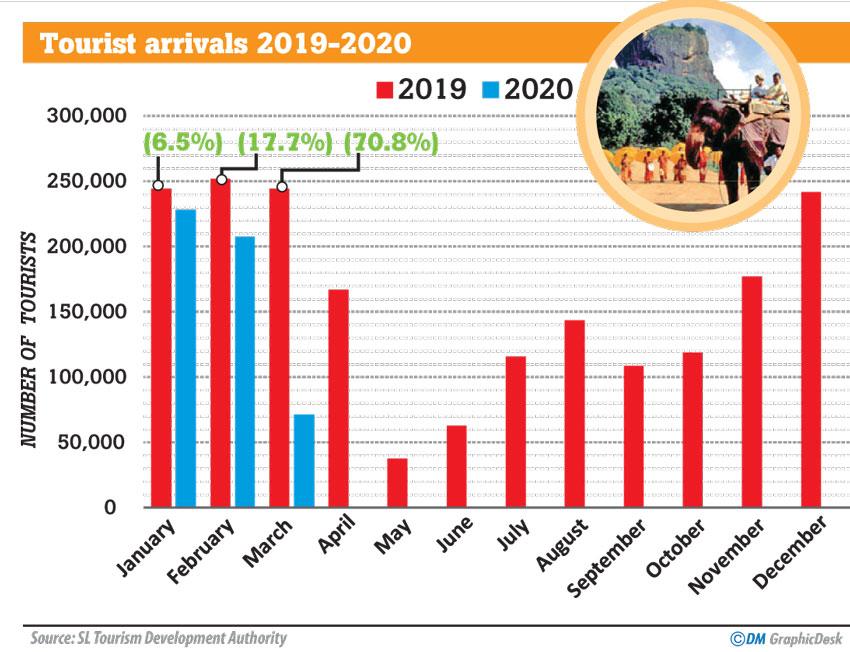27 Apr 2020 - {{hitsCtrl.values.hits}}

Tourist arrivals to Sri Lanka plunged in March and earnings slumped as COVID-19 continues to decimate the tourism sector, which accounts for 12.5 percent of Sri Lanka’s gross domestic product (GDP), according to World Bank estimates.
The arrivals fell to 71, 370 in March, falling to about a third of the visitors the country had a year ago, a decline of 70.8 percent a year ago, the statistics from Sri Lanka Tourism Development Authority (SLTDA) showed.
Travel and tourism has been the worst hit industry in the world from the global health crisis. The sector grounded to a halt since the World Health Organisation (WHO) announced the new coronavirus as a pandemic.
In March 2019, the total tourist arrivals were 244, 328, the peak the country reached before the industry was hit by Easter attacks in April that year, which sent the arrivals down by 70 percent in the following month.
Meanwhile, the March 2020 arrivals fell from the previous month’s 252,033 arrivals.
Until December 2019, the arrival numbers were nearing to close the gap between the year earlier numbers as the industry was recovering fast from the plunge caused by the Easter attacks.
All in all, the first three months’ arrivals were down steeply by 31.5 to percent to 507, 311 from 740, 600 in the first three months in 2019. Industry analysts however fear the worst is yet to come with global travel having hit the ‘rock bottom.’
Arrivals from all regions and countries showed a sharp decline with China leading with 92.9 percent decline to 1,688 from 23,759 visitors a year ago.
India, being the largest source market for Sri Lanka recorded a decline in arrivals by 63.8 percent to 12, 600 followed by Russia with 8,833 arrivals, down 30.5 percent.
Europe being the largest source market by region, which accounted for 60 percent of the total arrivals in March, showed a similar pattern with key markets such as United Kingdom, Germany and France recording between 63 percent to 73 percent decline in arrivals.
Meanwhile, earnings from tourism in the month of March 2020 also fell sharply to US$ 134.5 million or less than one third of what it earned a year earlier. The three months’ earnings also fell by 31.5 percent to US$ 956.2 million.
In March 2019, Sri Lanka earned US$ 460.5 million from the tourism industry, bringing the first three months’ earnings to US$ 1, 395.9 million.
Last week, Fitch Ratings downgraded Sri Lanka’s sovereign rating to ‘B-’ with a Negative outlook on heightened concerns on public and external debt sustainability and the weak fiscal conditions amplified by the pandemic, a stance vehemently refuted by the Sri Lankan government terming it as ill-timed, ill-logical and a rushed judgment.
Fitch singled out the impact on the tourism sector combined with weaker domestic demand to further damage Sri Lanka’s public and external finance metrics and said potential for economic recovery in 2021 hinges on early return of tourism receipts and increased domestic activity but that remains uncertain and depend on the course of the pandemic.
The rating agency estimated the plunge in the tourism earnings, remittances and weaker exports to widen the current account deficit to 3.3 percent of GDP this year despite some relief from lower oil prices from 2.2 percent in 2019 before narrowing to 2.3 percent in 2021.
Fitch’s rating action assumes gradual recovery of the global tourism industry from late 2020 or early 2021.
17 Nov 2024 1 hours ago
17 Nov 2024 2 hours ago
17 Nov 2024 5 hours ago
17 Nov 2024 5 hours ago
17 Nov 2024 5 hours ago